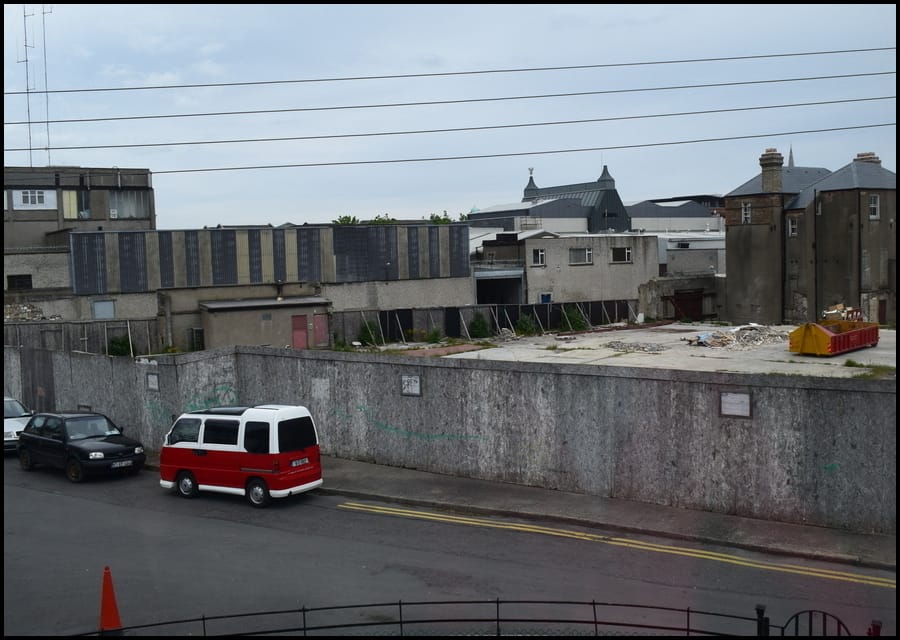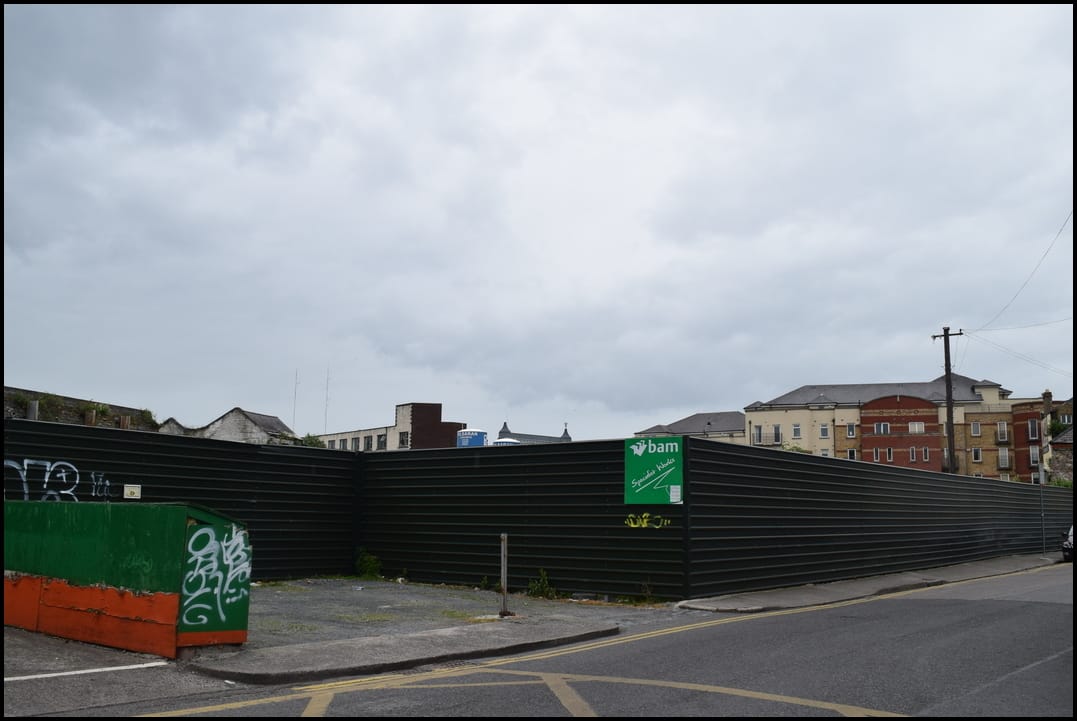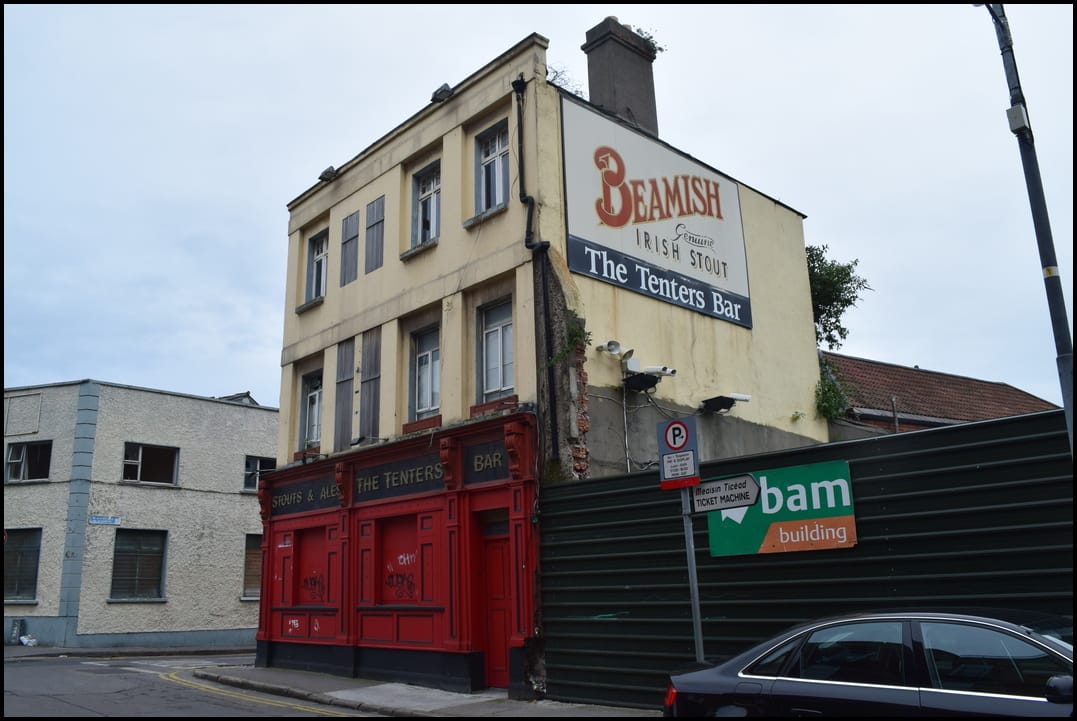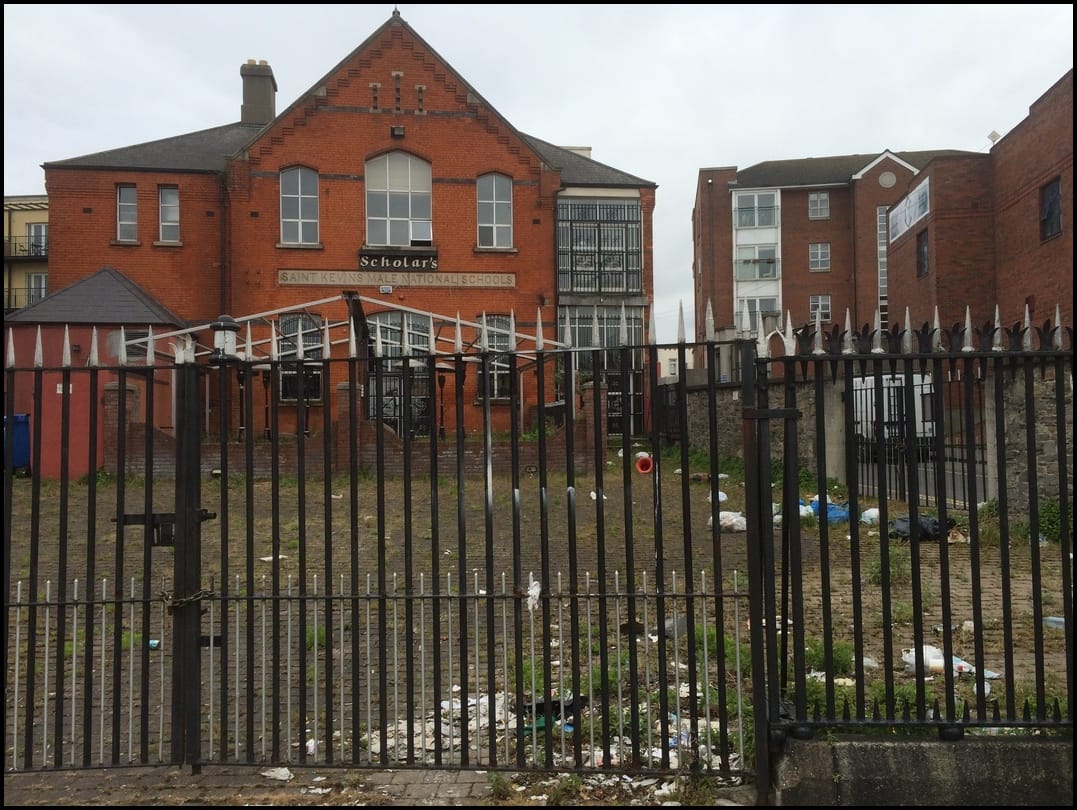What’s the best way to tell area residents about plans for a new asylum shelter nearby?
The government should tell communities directly about plans for new asylum shelters, some activists and politicians say.
When the crash hit, Blackpitts was left with craters of empty, derelict sites. With over 600 new bed spaces, plus bars, restaurants, offices, and more on the way, can it cope when developers come crawling back?

Along the side streets of Blackpitts in Dublin 8, plans are under way for 406 student beds, 188 hotel rooms, 149 nursing home beds, four new apartments in a converted school, eight shops, at least two restaurants, at least one bar, several offices, two art galleries, a student centre, an event space, and a science-and-technology centre.
In the mid-2000s, Blackpitts popped up frequently in newspaper property sections, but before bricks were laid on three of the biggest plans for the area, the crash hit.
Ten years on, and some of the main companies involved in the sites are now either dissolved or in liquidation, while another sold its Blackpitts site at a fraction of the boom-time price it originally paid.
But with the economy now moving towards recovery, developers are dusting off the old planning permissions. Not all residents are happy.
“It’s concerning to see these plans being brought back from the boom times. Areas change, but at times you get the impression that this isn’t taken into account,” said Thomas Corrigan, who’s lived in the neighbourhood for 64 years.
“When the crash hit and these plans were put on hold, we thought, ‘Great, that’s the end of it’. But now it looks like we’re back in it,” he said.
One of three site lies on Mill Street, just around the corner from the north end of Blackpitts. In June 2006, the huge patch was approved for 211 apartments, ten shops, and some offices.
At the moment, it’s little more than an empty space – two piles of debris from previous work, bordered by chipboard hoarding that’s seen better days, with some scattered equipment as a clue that work will start soon.
Number 10, a protected structure, was to be converted, and the Mission Hall building was to metamorphose into a microbrewery and bar, with the whole development being put in motion by Osprey Property, a subsidiary of Eircom.
Nine years on, with Osprey in liquidation since 2012, and more than 200 documents having gone through the Dublin City Council planning offices, Dubai-owned Global Student Accommodation (GSA) is in with The Creedon Group and €41 million to develop the site.
Its plans include a seven-storey, 406-bed student accommodation building, plus facilities, shops, offices, and a restaurant.
Next to the students will be the 149-bed nursing home – although an appeal has been lodged with Dublin City Council which raises concerns about whether its the best idea to plonk a nursing home next to student accommodation.
In June 2005, when the first cover letter was sent with plans for the Mill Street site, the development of a seven-storey block attracted 92 objection and observation letters to Dublin City Council.
The fears were the familiar fare: some residents worried that their homes would be overshadowed and overlooked, and many were suspicious that a restaurant or pub, as proposed, would atrophy into a superpub over time.
The most frequent concern, though, was the increased traffic and demand for parking that would be brought to the quiet, residential Blackpitts area. This concern hasn’t gone away.
Noel and Kay Clarke have this seven-storey development on their doorstep, with the proposed main entrance only metres from their front door, and they have been fighting the plans for the past decade. “It’s a very residential area and it will become chaotic with these plans going ahead,” Noel Clarke said recently.

Next to the Mill Street development, on Blackpitts, lies the site of Dutch-owned BAM Property’s proposed hotel.
In recent weeks, two vats of cement have arrived. Aside from this change, though, the site has been empty, surrounded by green metal hoarding, for years.

The derelict Tenters Pub still carries its signage, plus a billboard on the gable wall, but broken windows, peeling red paint, and a badly damaged front wall stand out at the Mill Street and Blackpitts corner.

Stretching south and west from the pub, this space was owned by Paddy Kelly’s RedQuartz Boundary during the boom – the company dissolved post-crash, with its directors in multi-million-euro debt, but they did well on this one when it sold up to BAM for €30m in 2007.
In 2009, BAM switched existing planning permission from 100 apartments to a 188-bed hotel. The switch was granted, but the site has lain idle since.
The latest records for the site show this planning permission was extended in 2013 to 2019, and a spokesperson for BAM Property said “the company is actively working on the development of the site”.
Soon enough, then, the hotel is expected to arrive with a restaurant, a bar, an “event space”, four shops, two offices, two art galleries, a science-and-technology centre, plus parking and bike spaces.
When planning permission was granted to RedQuartz Boundary in 2005, 13 letters were lodged.
Local residents pointed to the height of the proposed eight-storey development and the increased traffic it would bring. In particular, several letters pointed to the number of children in the area, walking to and from school each day.
“There are a lot of schools in the area, and developments like this don’t add anything for the school-going population,” said Celia Keenan, a neighbor of the school for many years.
“When you’re walking around here you’ll see St Patrick’s Cathedral and Christchurch popping up over the skyline every so often, and it’s nice that you can be taken by surprise with that because the buildings are very low. If two seven-storey buildings come along, it will be easier in future for other developers to get taller buildings through.”
A 30-second stroll from BAM’s site is the former Scholar’s Bar, built within what was originally St Kevin’s National School and derelict since closure in 2011.
You might remember it best from headlines in 2007 when its late licence was revoked after a 15-year-old – who was “too drunk to stand up” – was arrested there.
Its licence was reinstated on appeal, but the pub could have closed long before this when it applied for a seven-storey block of 41 apartments, with four shops, in 2006. Those plans were rejected, and before development could be reassessed, the crash hit.
For the past four years, the site has been derelict and has made frequent appearances on websites The Dublin Litter Blog and FixMyStreet, as it turned into a favourite for local fly-tippers although the current owners have cleaned the site on occasion.

Inside the building, at the moment, are the remnants of a pub. Bar stools are stacked at the sides of rooms, furniture and timber is piled throughout, and the bar sits unmanned, its taps gathering dust.
Scholars was sold for €2.5 million in 2002, but went to the market in 2011 for only €700,000, after a price tag of €1 million wasn’t matched.
New owner Arcticom Ltd, a company based in Rathfarnham, has now lodged plans for the site. Those were for five two-bedroom flats, plus two three-bedroom flats with a restaurant or bar, but in the last few weeks, a decision by An Bord Pleanála looks set to reduce this to four two-bedroom apartments.
Such plans would still involve a substantial renovation of the old National School, including converting it from a two-storey to three-storey building, but plans outline that the National School facade will be kept.
Whether this site will go ahead as permitted remains to be seen, but there are concerns about the site going back to its failed planning application in 2006 – eight letters to the council in this case, including one from the then local Labour TD Mary Upton, mentioned overshadowing, traffic congestion, and the heritage importance of the St Kevin’s National School building.
The fact that derelict sites around Blackpitts could be built up is welcome, but residents are wary that the area is being dragged back into boom-time planning rows.
“A lot of sites in Dublin 8 have been lying derelict since the crash and some of the plans that were attached to them during the boom were bordering on fantasy . . . so it’s a bit worrying to see that old plans are being brought back,” said Martin Maguire, one such resident.
At the heart of their concerns is the nature of the Blackpitts area.
Unlike many parts of Dublin that were over-developed and poorly planned during the Tiger years, this neighbourhood has survived.
“We’re one of the only small, inner-city dwelling areas left in Dublin, and you can see how quiet it is while we’re talking here,” said long-time resident Corrigan. “But we just don’t know if it will stay the same way.”
“I’ve lived in this area for 64 years, I grew up with most of the people here, and I love it – it’s a fantastic place. But the young couples that we see moving in now – they just don’t know what’s going to happen to the area that they could spend the rest of their life in.”
It’s not like all residents are against any development in the area. Many would love to see something replacing the blight of derelict sites.
“What we really need around here, like the rest of Dublin, is social housing,” says Maguire.
There’s frustration, as well, when locals have to fight for small improvements to the area.
As Corrigan puts it: “You see local residents having to battle the council planners to get a small extension put on, or to change their driveway, and we have to fight for everything like a small bike rack or some street cleaning . . . then permission is granted for them to smack up these big blocks.”
Noel Clarke agrees: “We’d like to see the sites developed if it was something that was compatible with the area and that benefits the area, not just something that jacks up a load of money for developers. In general, with the new developments they’re not considering the local area at all.”
Local Labour councillor labour.ie/rebeccamoynihan/”>Rebecca Moynihan points to several recent developments that have brought more people to the side streets of Dublin 8. The €10 million Teeling’s Whiskey distillery, which has recently opened in Newmarket, only metres from Blackpitts, is aiming to bring in 50,000 visitors per year, for example.
Adding to this is the bustling Dublin Food Co-op, and monthly flea markets – which mean “parking in the area is already at capacity,” she said in an observation letter to the Council, concerning the Mill Street development.
What’s more, in the next few weeks an announcement is expected from the Dublin Whiskey Company, setting up on Mill Street as well.
Moynihan says she wants planners to think about sustainable approaches to transport, such as a shared bike scheme for the area.
BAM Property has declined to comment on the impact their development could have on the area, while developers on the other two sites did not respond to questions.
Dublin City Council’s press office gave a boilerplate response: “All planning applications are assessed with regard to the proper planning and sustainable development of the area. Matters such as traffic, parking, aesthetics and any other material issues are considered as part of the assessment of any application.”
The question so often asked during the boom is back: when developers come along with money to spend, will planners find a way to develop derelict Dublin without engulfing local neighbourhoods?
Along Blackpitts, they aren’t so sure.
“It’s a disgrace,” says Kay. “But they have the money to do it and that’s what matters. They got the planning permission, so what can we do? We’re going back to the boom times with these plans, and I just think that’s crazy.”